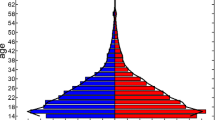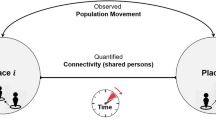Abstract
Space and place are two fundamental concepts in geography. Geographical factors have long been known as drivers of many aspects of people’s social networks. But whether and how space and place affect social networks differently are still unclear. The widespread use of location-aware devices provides a novel source for distinguishing the mechanisms of their impacts on social networks. Using mobile phone data, this paper explores the effects of space and place on social networks. From the perspective of space, we confirm the distance decay effect in social networks, based on a comparison between synthetic social ties generated by a null model and actual social ties derived from real-world data. From the perspective of place, we introduce several measures to evaluate interactions between individuals and inspect the trio relationship including distance, spatio-temporal co-occurrence, and social ties. We found that people’s interaction is a more important factor than spatial proximity, indicating that the spatial factor has a stronger impact on social networks in place compared to that in space. Furthermore, we verify the hypothesis that interactions play an important role in strengthening friendships.










Similar content being viewed by others
References
Agnew J (1987) Place and politics: the geographical mediation of state and society. Allen and Unwin, Boston
Arentze T, Timmermans H (2008) Social networks, social interactions, and activity-travel behavior: a framework for microsimulation. Environ Plan 35:1012–1027
Barthélemy M (2011) Spatial networks. Phys Rep 499:1–101
Bollen KA (1989) Structural equations with latent variables. Wiley, New York
Cairncross F (2001) The death of distance: how the communications revolution will change our lives. Harvard Business Press, Cambridge
Carrasco JA, Miller EJ (2006) Exploring the propensity to perform social activities: a social network approach. Transportation 33:463–480
Cho E, Myers SA, Leskovec J (2011) Friendship and mobility: user movement in location-based social networks. In: Proceedings of the 17th international conference on knowledge discovery and data mining, ACM, New York, pp 1082–1090
Choudhury MD, Mason WA, Hofman JM, Watts DJ (2010) Inferring relevant social networks from interpersonal communication. In: Proceedings of the 19th international conference on world wide web, ACM, New York, pp 301–310
Crandall DJ, Backstrom L, Cosley D, Suri S, Huttenlocher D, Kleinberg J (2010) Inferring social ties from geographic coincidences. Proc Natl Acad Sci USA 107:22436–22441
Eagle N, Pentland AS, Lazer D (2009) Inferring friendship network structure by using mobile phone data. Proc Natl Acad Sci USA 106:15274–15278
Erdős P, Rényi A (1976) On the evolution of random graphs. Sel Pap Alfréd Rényi 2:482–525
Gao S, Liu Y, Wang Y, Ma X (2013) Discovering spatial interaction communities from mobile phone data. Trans GIS 17:463–481
González MC, Hidalgo CA, Barabási AL (2008) Understanding individual human mobility patterns. Nature 453:779–782
Goodchild MF (2015) Space, place and health. Annals of GIS 21:97–100
Granovetter MS (1973) The strength of weak ties. Am J Sociol 78:1360–1380
Hawelka B, Sitko I, Beinat E, Sobolevsky S, Kazakopoulos P, Ratti C (2014) Geo-located Twitter as proxy for global mobility patterns. Cartogr Geogr Inf Sci 41:260–271
Kang C, Ma X, Tong D, Liu Y (2012) Intra-urban human mobility patterns: an urban morphology perspective. Phys A 391:1702–1717
Kang C, Sobolevsky S, Liu Y, Ratti C (2013) Exploring human movements in Singapore: a comparative analysis based on mobile phone and taxicab usages. In: Proceedings of the 2nd international workshop on urban computing, no. 1. ACM, New York
Kwan M-P (2007) Mobile communications, social networks, and urban travel: hypertext as a new metaphor for conceptualizing spatial interaction. Prof Geogr 59:434–446
Lewis RA, Reiley D (2008) Does retail advertising work? Measuring the effects of advertising on sales via a controlled experiment on Yahoo!. http://dx.doi.org/10.2139/ssrn.1865943
Liben-Nowell D, Novak J, Kumar R, Raghavan P, Tomkins A (2005) Geographic routing in social networks. Proc Natl Acad Sci USA 102:11623–11628
Onnela J-P, Saramäki J, Hyvönen J, Szabó G, Lazer D, Kaski K, Kertész J, Barabási A-L (2007) Structure and tie strengths in mobile communication networks. Proc Natl Acad Sci USA 104:7332–7336
Onnela JP, Arbesman S, González MC, Barabási AL, Christakis NA (2011) Geographic constraints on social network groups. PLoS One 6:e16939
Phithakkitnukoon S, Smoreda Z, Olivier P (2012) Socio-geography of human mobility: a study using longitudinal mobile phone data. PLoS One 7:e39253
Pickles J (1995) Ground truth: the social implications of geographic information systems. Guilford Press, Newyork
Raeder T, Lizardo O, Hachen D, Chawla NV (2011) Predictors of short-term decay of cell phone contacts in a large scale communication network. Social Netw 33:245–257
Ratti C, Sobolevsky S, Calabrese F, Andris C, Reades J, Martino M, Claxton R, Strogatz SH (2010) Redrawing the map of Great Britain from a network of human interactions. PLoS One 5:e14248
Shi L, Chi G, Liu X, Liu Y (2015) Human mobility patterns in different communities: a mobile phone data-based social network approach. Ann GIS 21:15–26
Song C, Qu Z, Blumm N, Barabási A-L (2010) Limits of predictability in human mobility. Science 327:1018–1021
Sui D, Goodchild M (2011) The convergence of GIS and social media: challenges for GIScience. Int J Geogr Inf Sci 25:1737–1748
Sun L, Axhausen KW, Lee D-H, Huang X (2013) Understanding metropolitan patterns of daily encounters. Proc Natl Acad Sci USA 110:13774–13779
Takhteyev Y, Gruzd A, Wellman B (2012) Geography of Twitter networks. Social Netw 34(1):73–81
Tranos E, Nijkamp P (2015) Mobile phone usage in complex urban systems: a space–time, aggregated human activity study. J Geogr Syst 17:157–185
Tuan Y-F (1977) Space and place: the perspective of experience. University of Minnesota Press, Minneapolis
Van den Berg P, Arentze T, Timmermans H (2009) Size and composition of ego-centered social networks and their effect on geographic distance and contact frequency. Transp Res Rec 2135:1–9
Walsh F, Pozdnoukhov A (2011) Spatial structure and dynamics of urban communities. In: Proceedings of the first workshop on pervasive urban applications (PURBA)
Watts DJ, Strogatz SH (1998) Collective dynamics of ‘small-world’ networks. Nature 393:440–442
Acknowledgments
This research was supported by the National Natural Science Foundation of China (Grant nos. 41271386 and 41428102). The authors are grateful to anonymous referees for their constructive comments.
Author information
Authors and Affiliations
Corresponding author
Rights and permissions
About this article
Cite this article
Shi, L., Wu, L., Chi, G. et al. Geographical impacts on social networks from perspectives of space and place: an empirical study using mobile phone data. J Geogr Syst 18, 359–376 (2016). https://doi.org/10.1007/s10109-016-0236-8
Received:
Accepted:
Published:
Issue Date:
DOI: https://doi.org/10.1007/s10109-016-0236-8
Keywords
- Geographical impacts
- Space and place
- Spatially-embedded social networks
- Mobile phone data
- Individuals’ interaction




